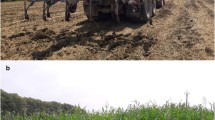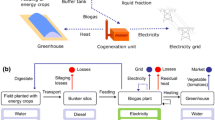Abstract
During the last years, a demand for regionally produced biogas feedstocks was created by government subsidies to biogas production in Germany—contrary to the trend of specialization of agricultural production towards global commodity markets. The question arose whether this trend could contribute to an increased cultivation of uncommon crops and diversification of cropping patterns, owing to comparably different and less restricted feedstock requirements. In the cooperative research project “EVA,” a multi-site experimental crop rotation field trial was conducted over 8 years at eight sites, representing the variety of soil-climatic conditions in Germany. The aim of the trial was to assess a variety of established and novel crops for anaerobic digestion. This paper presents the key findings of the trial. Special emphasis is given to biomass productivity and profitability. The chances for the approach “diversification of cropping patterns via energy cropping” are discussed. Results show that maize (average 4-year dry matter yield varied site-specific between 14.22 and 25.12 t ha−1) is clearly the most efficient crop for biogas production in Central Europe. Some cropping options for biogas feedstock production, such as winter triticale (whole crop, average yield of 6.71 to 15.17 t ha−1) or perennial fodder mixtures (average yield of 7.51 to 19.44 t ha−1) are feasible choices for farmers in some regions, which could contribute to diverse cropping systems.







Similar content being viewed by others
Notes
However, other overhead costs like machinery shelter were not included but assumed to be constant.
References
Eurostat (2017a) Eurostat – statistics explained. Agri-environmental indicator – specialization http://eceuropaeu/eurostat/statistics-explained/indexphp/Agri-environmental_indicator_-_specialisation Accessed: 26th Jan 2018
Eurostat (2017b) Eurostat – statistics explained. Agri-environmental indicator - cropping patterns http://eceuropaeu/eurostat/statistics-explained/indexphp/Agri-environmental_indicator_-_cropping_patterns Accessed: 26th Jan 2018
Dury J, Schaller N, Garcia F, Reynaud A, Bergez JE (2012) Models to support cropping plan and crop rotation decisions. A review. Agron Sustain Dev 32:567–580. https://doi.org/10.1007/s13593-011-0037-x
Pannell DJ, Tillie P, Rodriguez-Cerezo ED, Frisvold GB (2017) Herbicide resistance: economic and environmental challenges. AgBioForum 19:136–155
European Parliament and the Council of the European Union (2009) Regulation (EC) No 1107/2009 of the European Parliament and the Council of the European COUNCIL of 21 October 2009 concerning the placing of plant protection products on the market and repealing Council Directive 79/117/EEC and 91/414/EEC. Off J Eur plant protection products on the market and repealing Council Directive 79/117/EEC and 91/414/EEC. Off J Eur Union, L 309/1 – L309/50
Agency for Renewable Resources FNR e.V. (2017) Bioenergy in Germany: facts and figures 2016. Gülzow. http://www.fnr.de/fileadmin/allgemein/pdf/broschueren/Broschuere_Basisdaten_Bioenergie_englisch_2017.pdf. Accessed: 27 Jul 2018
German Biogas Association (2017) Biogas market data in Germany 2017/18. https://www.biogas.org/edcom/webfvb.nsf/id/DE_Branchenzahlen/$file/18-07-05_Biogasindustryfigures-2017-2018_english.pdf. Accessed: 27. Jul 2018
Weiland P (2010) Biogas production. Current state and perspectives. Appl Microbiol Biotechnol 85:849–860. https://doi.org/10.1007/s00253-009-2246-7
Amon T, Amon B, Kryvoruchko V, Zollitsch W, Mayer K, Gruber L (2007) Biogas production from maize and dairy cattle manure - influence of biomass composition on the methane yield. Agric Ecosyst Environ 118:173–182. https://doi.org/10.1016/j.agee.2006.05.007
Herrmann A (2013) Biogas production from maize: current state, challenges and prospects. 2. Agronomic and environmental aspects. Bioenerg Res 6:372–387. https://doi.org/10.1007/s12155-012-9227-x
Wagner M, Knoblauch S (2011) Water use efficiency and water use of Sorghum bicolor in comparison to energy maize. In: 14th Gumpensteiner Lysimetertagung. Lysimeter in der Klimafolgenforschung und Wasserwirtschaft. Raumberg-Gumpenstein. Austria. 3rd/ 4th May, vol 2011, pp 215–218
Grebe S, Stülpnagel R, Wachendorf M (2006) Vergleich von Triticale-Sorten und einzelnen Weizen-Sorten hinsichtlich Teil- und Ganzpflanzenerträgen für die Herstellung von Biogas und Ethanol bzw. zur thermisch/stofflichen Verwertung (“Sunfuel”) [Comparison of triticale breeds and winter wheat breeds with regard to whole-crop and crop-part yields for the production of biogas and ethanol or thermal/material use]. Mitt Ges Pflanzenbauwiss 18:202–203
Bischof R, Vetter A (2012) Optimierung des Anbauverfahrens Ganzpflanzengetreide, inklusive Arten- und Sortenmischungen für die Biogaserzeugung. Schlussbericht. [Optimization of cropping techniques for whole-crop cereals, including species and breed mixtures for biogas production. Final report.] Gefördert durch das Bundesministerium für Ernährung, Landwirtschaft und Verbraucherschutz. Thüringer Landesanstalt für Landwirtschaft, Agrarwissenschaftliche Bibliothek www.tll.de/ainfo/pdf/opti0812.pdf. Accessed: 26 Jan 2018
Schreiber E, Guddat C, Jentsch U (2010) Sortenversuche in Thüringen - Wintergerste, Winterroggen, Wintertriticale und Sommerhafer, Ganzpflanzengetreide zur Biogasgewinnung [Cultivar evaluation experiments in thuringia: winter barley, winter rye, winter triticale and spring oat for biogas production]. Thüringer Landesanstalt für Landwirtschaft, Agrarwissenschaftliche Bibliothek http://www.tll.de/ainfo/pdf/lv_biog.pdf. Accessed 26 Jan 2018
Hübner M, Oechsner H, Koch S, Hrenn S, Schmiedchen B, Wilde P, Miedaner T (2011) Impact of genotype, harvest time and chemical composition on the methane yield of winter rye for biogas production. Biomass Bioenergy 35:4316–4323. https://doi.org/10.1016/j.biombioe.2011.07.021
Einhellig FA, Rasmussen JA (1989) Prior cropping with grain sorghum inhibits weeds. J Chem Ecol 15:951–960. https://doi.org/10.1007/BF01015190
Stein-Bachinger K, Fuchs S (2012) Protection strategies for farmland birds in legume-grass leys as trade-offs between nature conservation and farmers’ needs. Org Agric 2:145–162. https://doi.org/10.1007/s13165-012-0029-4
Strauß C, Hildebrandt C, Ammermann K (2017) Verbesserte Artenvielfalt durch den Anbau mehrjähriger Kulturarten zur Biogasproduktion? [Improved species richness by perennial cropping for biogas feedstock production?]. Natur und Landschaft 92:214–220. https://doi.org/10.17433/5.2017.50153467.214-220
The Association of German Agricultural Analytic and Research Institutes [VDLUFA] (2014) Standpunkt Humusbilanzierung, Eine Methode zur Analyse und Bewertung der Humusversorgung von Ackerland [Standpoint humus balance a method for analysis and evaluation of humus status of cropland]. p 21. Eigenverlag, Speyer
Graß R, Heuser F, Stülpnagel R, Piepho H-P, Wachendorf M (2013) Energy crop production in double-cropping systems: results from an experiment at seven sites. Eur J Agron 51:120–129. https://doi.org/10.1016/j.eja.2013.08.004
Schittenhelm S, Schroetter S (2013) Comparison of drought tolerance of maize, sweet sorghum and sorghum-sudangrass hybrids. J Agron Crop Sci 200:46–53. https://doi.org/10.1111/jac.12039
Lehtomäki A, Viinikainen TA, Rintala JA (2008) Screening boreal energy crops and crop residues for methane biofuel production. Biomass Bioenergy 32:541–550. https://doi.org/10.1016/j.biombioe.2007.11.013
Peter C, Glemnitz M, Winter K, Kornatz P, Müller J, Heiermann M, Aurbacher J (2017) Impact of energy crop rotation design on multiple aspects of resource efficiency. Chem Eng Technol 40:323–332. https://doi.org/10.1002/ceat.201600226
Glemnitz M, Eckner J, Aurbacher J, Kornatz P, Müller J, Heiermann M, Peter C (2015) Crop rotations as “cornerstone” of sustainable energy cropping – integrative evaluation of their agronomic, ecologic, economic and resource efficiency effects.In: Asp Appl Biol 131:117–128
Herrmann C, Plogsties V, Willms M, Hengelhaupt F, Eberl V, Eckner J, Strauß C, Idler C, Heiermann M (2016a) Methane production potential of various crop species grown in energy crop rotations. Landtechnik 71:194–209. https://doi.org/10.15150/lt.2016.3142
Herrmann C, Heiermann M, Idler C (2016b) Biogas crops grown in energy crop rotations: linking chemical composition and methane production characteristics. Bioresour Technol 206:23–35. https://doi.org/10.1016/j.biortech.2016.01.05838
European Council (2013) Commission Regulation (EU) No 284/2013 of 1 March 2013 setting out the data requirements for plant protection products. Official J Eur Union L 93/85
Dean A, Voss DT (1998) Design and analysis of experiments. Springer-Verlag, Berlin
Eckner J, Strauß C, Nehring A, Vetter A (2014) Entwicklung und Optimierung von standortangepassten Anbausystemen für Energiepflanzen im Fruchtfolgeregime Abschlussbericht. [Development and comparison of site-adapted cropping systems for energy crops in crop rotations. Final report]. Gefördert durch das Bundesministerium für Ernährung, Landwirtschaft und Verbraucherschutz. Thüringer Landesanstalt für Landwirtschaft, Agrarwissenschaftliche Bibliothek. https://www.db-thueringen.de/servlets/MCRFileNodeServlet/dbt_derivate_00030295/Energiepflanzen%20Endbericht1.pdf (Accessed: 26th Jan 2018)
Core Team R (2016) R: a language and environment for statistical computing [Internet]. Vienna, Austria. Available under: https://www.R-project.org/ (Accessed: 17th Jan 2018)
Bates D, Maechler M, Bolker B, Walker S (2015) Fitting linear mixed-effects models using lme4. J Stat Softw 67:1–48. https://doi.org/10.18637/jss.v067.i01.
Davison AC, Hinkley DV (1997) Bootstrap methods and their application. Cambridge University Press, Cambridge
VDI (2006) VDI standard procedures 4630: Fermentation of organic materials. Characterisation of the substrate, sampling, collection of material data, fermentation tests. (eds. Verein Deutscher Ingenieure (VDI)), Beuth Verlag, Berlin, Germany
The Association of German Agricultural Analytic and Research Institutes (2006) Die Chemische Untersuchung von Futtermitteln. Methodenbuch Band III [Chemical analysis of fodder. Methodological manual volume III] . 6th Supplementary Delivery, third ed. VDLUFA-Verlag, Darmstadt, Germany
Weißbach F, Kuhla S (1995) Substance losses in determining the dry matter content of silage and green fodder: arising errors and possibilities of correction. Übersicht Tierernährung 23:189–214
Association for Technology and Structures in Agriculture KTBL (2012b) Energiepflanzen. Daten für die Planung des Energiepflanzenanbaus [Energy crops. Data for the planning of energy crop production]. 2nd edition. Darmstadt
Schroers J O, Sauer N (2011) Die Leistungs-Kostenrechnung in der landwirtschaftlichen Betriebsplanung [Performance and cost accounting in farm planning]. KTBL Schrift 486. Darmstadt, 2011
Association for Technology and Structures in Agriculture KTBL (2012a) Betriebsplanung Landwirtschaft [farm operations planning agriculture]. 23rd edition. Darmstadt
Strauß C, Vetter A, Nehring A (2011) Site-specific cropping systems for biogas substrate production– excerpt of results II. Poster presented at the 9th Thuringian-Hungarian-Symposium. 25.10.2011. Jena
Carlsson G, Mårtensson LM, Prade T, Svensson SE, Jensen ES (2017) Perennial species mixtures for multifunctional production of biomass on marginal land. GCB Bioenergy 9:191–201. https://doi.org/10.1111/gcbb.12373
Schittenhelm S, Reus D, Kruse S, Hufnagel J (2011) Assessment of productivity and profitability of sole and double-cropping for agricultural biomass production. Journal für Kulturpflanzen 63: 387–395, ISSN 0027–7479. Ulmer, Stuttgart
Honermeier B, Gaudchau M (2004) Analyse und Bewertung der Vorfruchtwirkung von Winterraps [Analysis and evaluation of pre-crop effects of winter rapeseed]. Vorfruchtwert von Winterraps und Bekämpfung von Pilzkrankheiten in Körnerleguminosen. Ufop-Schriften 20: 1–27. Ufop. (ed). Berlin
Weiser C, Fuß R, Kage H, Flessa H (2018) Do farmers in Germany exploit the potential yield and nitrogen benefits from preceding oilseed rape in winter wheat cultivation? Arch Agron Soil Sci 64:25–37. https://doi.org/10.1080/03650340.2017.1326031
Strehlow B, de Mol F, Nehring A, Struck C, Gerowitt B (2010) Fruchtfolgen mit Energiepflanzen - Wurzel- und Stängelbasiskrankheiten in Wintergetreide an sieben Versuchsstandorten in Deutschland (EVA-Projekt). [Rotations with energy crops - root and stem diseases of winter cereals at seven experimental sites in Germany (EVA-project)]. Julius-Kühn-Archiv 428:57
Ball BC, Bingham I, Rees RM, Watson CA, Litterick A (2005) The role of crop rotations in determining soil structure and crop growth conditions. Can J Soil Sci 85:557–577
Rossberg D (2016) Survey on application of chemical pesticides in agriculture. J Kult 2(68):25–37. https://doi.org/10.5073/JFK.2016.02.01
Wüstholz R, Auburger S, Bahrs E (2014) Konsequenzen aus der Anrechnung von Gärresten pflanzlicher Herkunft auf die N-Ausbringungsobergrenze organischer Düngemittel und auf die Derogation – Status quo und Empfehlungen [Consequences from the inclusion of digestates from plant material sources onto the nitrogen limit of organic fertilizers and onto the derogation – status quo and recommendations]. Berichte über Landwirtschaft. Zeitschrift für Agrarpolitik und Landwirtschaft 92. https://doi.org/10.12767/buel.v92i3.50.g130
Stinner W, Möller K, Leithold G (2008) Effects of biogas digestion of clover/grass leys, cover crops and crop residues on nitrogen cycle and crop yield in organic stockless farming systems. Eur J Agron 29:125–134. https://doi.org/10.1016/j.eja.2008.04.006
CDU, CSU, SPD (2018) Koalitionsvertrag [coalition agreement for the German federal government]. Available under: https://www.bundesregierung.de/Content/DE/StatischeSeiten/Breg/koalitionsvertrag-inhaltsverzeichnis.html (Accessed: 27 Jul 2018)
Haughton AJ, Bohan DA, Clark SJ, Mallott MD, Mallott V, Sage R, Karp A (2016) Dedicated biomass crops can enhance biodiversity in the arable landscape. GCB Bioenergy 8:1071–1081. https://doi.org/10.1111/gcbb.12312
Acknowledgements
We would like to thank the partner institutions of the EVA-project for their reliable and effective collaboration.
Funding
The work of this study was carried out with the financial support of the Federal Ministry of Food and Agriculture by decision of the German Bundestag, through the Fachagentur Nachwachsende Rohstoffe e.V. which we would like to thank for the grateful support.
Author information
Authors and Affiliations
Corresponding author
Additional information
Publisher’s Note
Springer Nature remains neutral with regard to jurisdictional claims in published maps and institutional affiliations.
Rights and permissions
About this article
Cite this article
Strauß, C., Herrmann, C., Weiser, C. et al. Can Energy Cropping for Biogas Production Diversify Crop Rotations? Findings from a Multi-Site Experiment in Germany. Bioenerg. Res. 12, 123–136 (2019). https://doi.org/10.1007/s12155-019-9960-5
Published:
Issue Date:
DOI: https://doi.org/10.1007/s12155-019-9960-5




